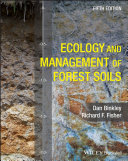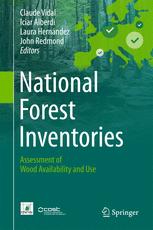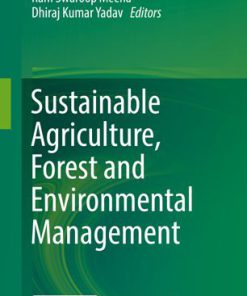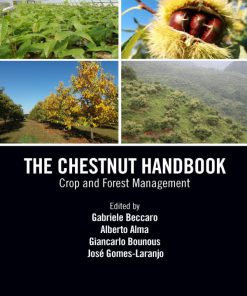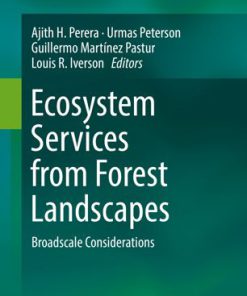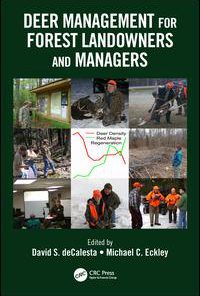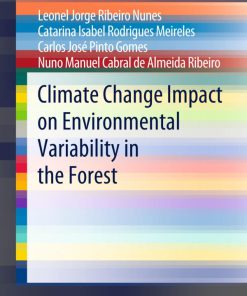Globalisation and Change in Forest Ownership and Forest Use 1st edition by Palgrave Macmillan 1137571160 9781137571168
$50.00 Original price was: $50.00.$25.00Current price is: $25.00.
Globalisation and Change in Forest Ownership and Forest Use 1st edition by Palgrave Macmillan – Ebook PDF Instant Download/Delivery:9781137571168,1137571160
Full download Globalisation and Change in Forest Ownership and Forest Use 1st edition after payment

Product details:
ISBN 10:1137571160
ISBN 13:9781137571168
Author:Palgrave Macmillan
This book describes the changing landscape of European forest ownership and explores the impact a new, often urban, generation of forest owners may have on the future of one of our most basic resources – forests. Forests have not played a major role in rural studies thus far, however they constitute an important part of many rural areas. Drawing on Swedish cases and comparison cases from various other areas of Europe, the authors present these ‘new forest owners’ as a pivotal factor in the changing relationships between urban and rural life. The chapters explore how forest production, the relationship to the environment, urban-rural relations and local communities have already changed as well as discussing what might be expected for the future. A result of work in the Swedish research programme PLURAL and related projects, such as the EU Cost Action FACESMAP, this volume will be of interest to scholars of forestry and rural studies, as well as to researchers in environmental, population and globalization studies more broadly.
Globalisation and Change in Forest Ownership and Forest Use 1st Table of contents:
1: Introduction
Introduction: Understanding Rural—And Urban—Change Through Small-Scale Private Forest Ownershi
What Is Forest in Rural Studies—And Who Are the Changing Forest Owners in Europe?
The Aims of This Book
References
2: Is There a New European Forest Owner? The Institutional Context
Introduction: The Construction of Forest Ownership
Changes in Forest Ownership and Use: Who May the New Forest Owner Be, and Why Does It Matter?
Changes in Forest Owner Groups in Europe
Forest Restitution: New Forest Owners in Eastern Europe After the Fall of the Soviet Union
Structural Change Within Established Forest Owner Traditions: The Example of New Owners in Fenn
The “New Forest Owner” as a Shift from an Agricultural Owner: New Owners in Examples in C
The Anglo-Saxon Case: Emphasised in Rural Literature but a Very Special Case?
Forest Owners in Further Transition?
Conclusions
References
3: Individual Forest Owners in Context
Introduction
Forest Ownership in a Changing World
Urbanisation and Land Use
Demographic and Socioeconomic Changes
Co-ownership
The Owner’s Perspective on Forest Ownership
Lifestyle
Social Influences
Place Attachment
Identity
Values and Attitudes in a Hierarchical Model
Forest Values
Objectives of Forest Ownership
Intentions and Behaviour
Discussion
A Pattern of Change
Forest Owners Today and in the Future
References
4: Interactions Between Forest Owners and Their Forests
Introduction
Existing Monitoring of Forest and Forest Owners
New Approaches to Surveying Forest and Forest Owner Interaction
Forest Change Analysis
Database for Forest Owner Analysis
How Forest Owners Interact with Their Forests
Where Is the Forest in Sweden, and Where Is the Population to Be Found?
How Far from the Owned Property Does the Forest Owner Live?
Who Is the Forest Owner?
How Different Forest Owners Manage Their Forest
How Much Do Different Forest Owners Harvest Their Forests?
How Much Do Different Forest Owners Harvest Their Forests at Municipal Level?
Did Forestry Activity Among NIPF Owners Change from 1992 to 2013?
Concluding Discussion
References
5: Is There an End to the Concentration of Businesses and People?
Introduction
Centripetal Forces: Agglomeration Economies and Population Dynamics
Examples of Successful Companies in Rural Settings
Challenging the Urban Assumption
Concluding Discussion
References
6: Rural-Urban Policies: Changing Conceptions of the Human-Environment Relationship
Introduction
The Concept of the Rural and Rural Change
Rural as Decline?
Rural as Amenity: Continued Production and Part-Time Residence?
Relational Ways of Viewing the Rural: Rural as Interconnection
Perspectives on Regional and Rural Development Policy
Rural Change and Policy in a Swedish Context
The Redistributive Tax System at Municipal Level
Managing the Challenges of Globalisation: A Role for Forest?
Conclusion
Appendix: The Municipality Tax Equalisation System
References
7: Multi-level Planning and Conflicting Interests in the Forest Landscape
Introduction
The Junction of Property Rights, Municipal Planning, and Forest Management: A Planning Dilemma
The Private Forest Owner’s Perception of, and Relationship to, Public Planning
Including Interests Beyond Forestry and Forest Owners Through Consultation: The Examples of Re
The Impact of EU Regulation on the Swedish Planning System: The Example of Natura 2000
Discussion: Understanding Land-Use Claims: Scenario Methodology as an Approach
Concluding Remarks
References
8: Forests in Common and Their Contribution to Local Development
Introduction
Forest: For Centuries a Contested Resource
Forest Held in Common
Material and Method
Cases Analysed Using the Sustainable Livelihood Framework
Regole d’Ampezzo
The Story
Five Capitals
Flows and Transformations
Outcomes on Different Scales
Älvdalens Besparingsskog
The Story
Five Capitals
Flows and Transformation
Outcome on Different Scale
Meščanska Korporacija Kamnik
The Story
Five Capitals
Flows and Transformation
Outcomes on Different Scale
North West Mull Community Woodland Company
The Story
The Five Capitals
Flows and Transformations
Outcomes at Different Scales
Concluding Discussion
References
9: Conclusions: New Forest Owners Under Globalised, Rural-Urban Relations
Introduction
Change Over Time as a Theme
Chapters in Context
Concluding Thoughts
People also search for Globalisation and Change in Forest Ownership and Forest Use 1st:
globalization and deforestation
global forest change
a global model for forecasting political instability
how has globalization changed the practice of forecasting
how has globalization affected north carolina’s textile industry
Tags:
Palgrave Macmillan,Globalisation,Change,Ownership
You may also like…
Uncategorized
Science (General)
National Forest Inventories Assessment of Wood Availability and Use 1st Edition Claude Vidal
Biology and other natural sciences - Plants: Agriculture and Forestry
Biology and other natural sciences - Ecology
Biology and other natural sciences - Ecology
Deer Management for Forest Landowners and Managers 1st Edition David S. Decalesta (Editor)
Science (General)
Climate Change Impact on Environmental Variability in the Forest Leonel Jorge Ribeiro Nunes




